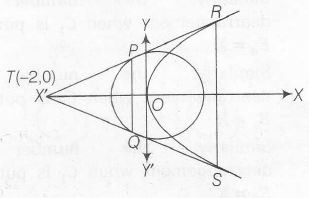Answer:
Option D
Explanation:
Plan
(i) $y=mx+\frac{a}{m}$ is equation of tangent to the parabola y2=4ax
(ii) A line is atangent to circle , if distance of line from centre is equal to the radius of circle.
(iii) Equation of chord drawn from exterior point (x1,y1) to a circle/parabola is given by T=0
(iv) Area of Trapezium= 1/2 ( sum of parallel sides) x ( distance between them)
Let equation of tangent to parabola be
$y=mx+\frac{2}{m}$
It also touches the circle x2+y2=2
$\therefore$ $ |\frac{2}{m\sqrt{1+m^{2}}}|=\sqrt{2}$
$\Rightarrow$ $ m^{4}+m^{2}=2$
$\Rightarrow$ $ m^{4}+m^{2}-2=0$
$\Rightarrow$ $ (m^{2}-1)(m^{2}+2)=0$
$\Rightarrow$ $m=\pm 1,m^{2}=-2$ (m2 =-2 rejected)
So , tangenth are y=x+2, y=-x-2, THey interset at (-2,0)

Equation of chord PQ is, -2x=2
$\Rightarrow$ x=-1
Equation of chord RS is O =4(x-2)
$\Rightarrow$ x=2
$\therefore$ Coordinates of P,Q,R,S are
P(-1,1), Q(-1,-1),R(2,4),S(2,-4)
Hence , are of PQRS = $\frac{(2+8)\times3}{2}=15 $ sq.units